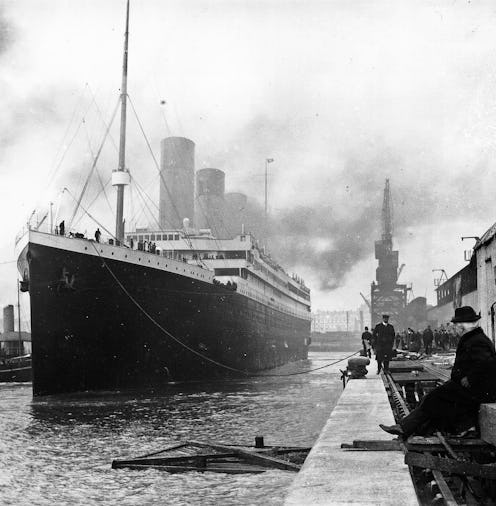Life
Is This Actually Why The Titanic Sank?
A new theory (well, sort of — more on that in a moment) regarding the sinking of the “unsinkable” RMS Titanic has scholars once again debating the shocking events that took place over 100 years ago. The Titanic fire theory, as it's informally known, proposes that it wasn’t just an icy “act of God” that downed the ship, but criminal negligence and a boiler room aflame are to blame, as well. (Sorry, Jack and Rose.) So where did this “new” Titanic theory come from? And why do I keep referring to it in quotation marks? The theory asserts that a fire left blazing in the boiler room for nearly three weeks weakened the ship's steel hull and aggravated the effect of the iceberg collision. Though you didn't see it in the movie, the extent of this fire has been one of the Titanic's great mysteries — but it turns out that it might be the key to, well, everything.
The fact that there was a fire aboard the Titanic has been publicly known since the 1912 inquiry in the disaster. However, journalist and Titanic expert Senan Molony, says its importance has been drastically underplayed. In the documentary Titanic: The New Evidence, Molony states that photographic evidence has recently come to light confirming the existence and extent of the fire. The photos in question, taken by one of the ocean liner's chief electrical engineers while docked in Belfast, show 30-foot long dark marks running along the right side of the ship, near the location where Titanic would later be fatally struck.
"Nobody has investigated these marks before. It totally changes the narrative," Molony told The Times. "We have metallurgy experts telling us that when you get that level of temperature against steel it makes it brittle, and reduces its strength by up to 75 percent." Molony also asserts that special care was taken so that passengers would not be aware of the fire or the damage it caused, and that the damaged side of the ship was intentionally faced away from the dock.
Theories concerning how the fire in bunker #6 could have contributed to the disaster have been floating around for more than a decade (hence the fact that the theory isn't exactly "new"). As Jalopnik points out, Ohio State University mechanical engineer Robert Essenhigh speculated at a 2004 meeting of the Geological Society Of America that the speed at which the Titanic was traveling that fateful day could have been due to crew members attempting to tamp down the flames. "The standard technique for controlling and eliminating such fires on steamships was to increase the rate at which the coal was being removed from the bunker and put into the steam engine boiler," states Science Daily, which, in turn, would make the ship speed up. As there is no confirmed reason why the luxury vessel would be traveling at top speed through icy waters, Essenhigh proposed that this was a likely scenario. The Titanic's speed of 22 knots was found at the inquiry to give the crew little time to alter course and avoid the iceberg.
In 2008, another theory came to light in regards to the fire. The Independent reported that Titanic researcher Ray Boston, backed up by 20 years of study, asserted that the fire, which started during speed trials, turned the ship into a "floating time bomb." Boston proposed that the "excessive" speed was due to orders from John Pierpont Morgan, the owner of the ship, to get it to New York as fast as possible before "serious explosions" occurred.
The importance of the Titanic fire has been gaining momentum through the years, and may soon change the way we think about the deadliest maritime disaster to occur during peacetime. Next, researchers may want to focus on another important question: Was there really enough room for Leo on that door?
